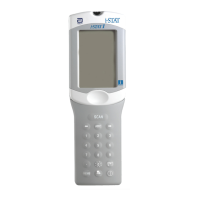CK-MB - 2 Art: 716675-00L Rev. Date: 03-Aug-12
Metrological Traceability
The i-STAT System test for creatine kinase-MB (CK-MB) measures creatine kinase-MB amount-of-
substance concentration mass in plasma or the plasma fraction of venous whole blood (dimension ng/
mL) for in vitro diagnostic use. Creatine kinase-MB values assigned to i-STAT System controls are
traceable to the American Association of Clinical Chemists (AACC recombinant human CK-MB from
Seradyn Inc.) calibrator for the standardization of creatine kinase mass assays. i-STAT System controls
and calibration verification materials are validated for use only with the i-STAT System and assigned
values may not be commutable with other methods. Further information regarding metrological
traceability is available from Abbott Point of Care Inc..
Reportable Range
The i-STAT CK-MB test will report 0.0 to 150.0 ng/mL (µg/L). Samples above the reportable range will
yield “>150.0 ng/mL” on the analyzer display screen.
Reference Range
Whole blood and plasma samples from 161 apparently healthy donors were assayed in duplicate using
3 different lots of i-STAT CK-MB cartridges. The 0 to 95% range of results spanned 0.0 ng/mL (µg/L) to
3.5 ng/mL (µg/L).
Note: Each facility should establish its own reference range using the i-STAT CK-MB assay.
Clinical Significance
CK-MB mass has been reported to be useful for the diagnosis of myocardial infarction, re-infarction, and
the sizing of infarction.
For optimal diagnostic usefulness, a cardiac marker should be specific for cardiac tissue, should be
rapidly released into the bloodstream with a direct proportional relationship between the extent of
myocardial injury and the measured level of the marker, and should persist in blood for a sufficient length
of time to provide a convenient diagnostic time window.
1
Creatine kinase (CK) is a dimeric enzyme found primarily in brain and muscle tissue. There are 3
isoforms of creatine kinase: BB, MM, and MB. BB is found primarily in the brain. Skeletal muscles
primarily contain the MM isoform, with traces of MB (estimates of 1-4% of CK activity). Cardiac
muscles also contain primarily the MM isoform, but higher amounts of MB, typically around 20% of CK
activity.
2
Serum from healthy individuals typically contains the MM isoform and a small amount of the
MB isoform.. CK-MB can be released into the bloodstream by a number of actions, including skeletal
muscle injury and myocardial damage.
The rise in CK-MB in the bloodstream occurs between 4-6 hours following a myocardial infarction (MI).
The concentration peaks after approximately 24 hours and returns to baseline after 36-72 hours. As
the level of CK-MB is not cardiac specific, the results of a single test are not indicative of a myocardial
infarction (MI). Typically an MI is diagnosed based on the pattern of CK-MB analyses taken at 3 hour
intervals for a 6 to 9 hour period or at 6 to 8 hour intervals for a 24 hour period.
Although the cardiac-specific troponins, troponin I (cTnI) and troponin T (cTnT) are now considered
the biochemical markers of choice in the evaluation of acute coronary syndromes (ACS) including ST-
elevation myocardial infarction, non-ST-elevation myocardial infarction, and unstable angina, CK-MB
can also be used as a secondary marker to aid in the diagnosis of myocardial infarction and measuring
the degree of myocardial necrosis. Since low levels of CK-MB can be detected in the blood of healthy
persons, any CK-MB value above the 95th percentile may be indicative of some degree of myocardial
necrosis.
1
Each institution should establish its own reference range for its patient population, and this
range should be used to determine an appropriate limit indicative of acute myocardial infarction (AMI).
The European Society of Cardiology / American College of Cardiology consensus document notes that
in the clinical setting of a reinfarction, CK-MB may be more useful for monitoring for MI than cardiac
troponin I (cTnI) or cardiac troponin T (cTnT) because CK-MB remains increased for only 2-4 days

